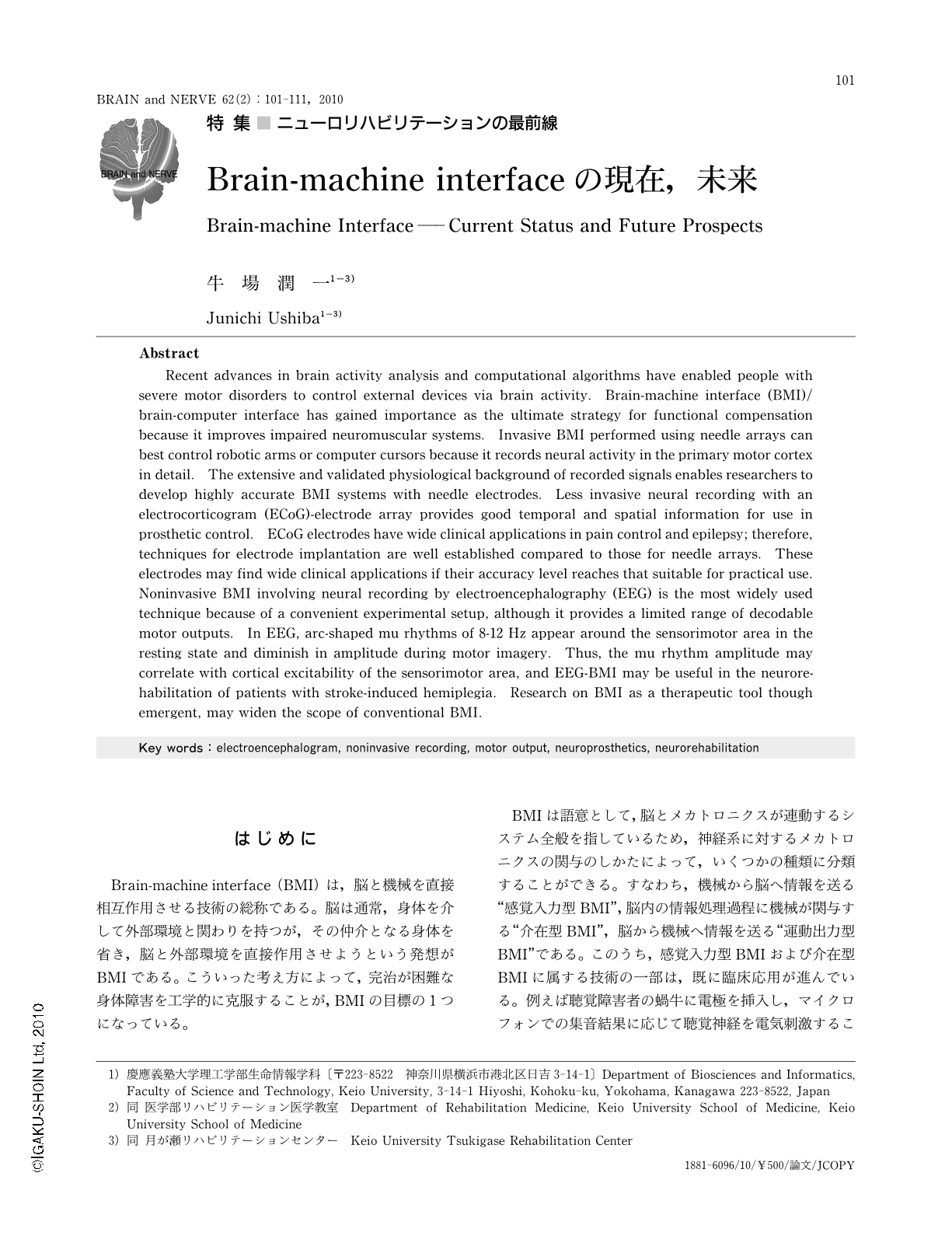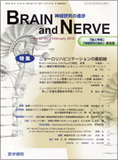Japanese
English
- 有料閲覧
- Abstract 文献概要
- 1ページ目 Look Inside
- 参考文献 Reference
はじめに
Brain-machine interface(BMI)は,脳と機械を直接相互作用させる技術の総称である。脳は通常,身体を介して外部環境と関わりを持つが,その仲介となる身体を省き,脳と外部環境を直接作用させようという発想がBMIである。こういった考え方によって,完治が困難な身体障害を工学的に克服することが,BMIの目標の1つになっている。
BMIは語意として,脳とメカトロニクスが連動するシステム全般を指しているため,神経系に対するメカトロニクスの関与のしかたによって,いくつかの種類に分類することができる。すなわち,機械から脳へ情報を送る“感覚入力型BMI”,脳内の情報処理過程に機械が関与する“介在型BMI”,脳から機械へ情報を送る“運動出力型BMI”である。このうち,感覚入力型BMIおよび介在型BMIに属する技術の一部は,既に臨床応用が進んでいる。例えば聴覚障害者の蝸牛に電極を挿入し,マイクロフォンでの集音結果に応じて聴覚神経を電気刺激することで聴覚を再建する人工内耳システム1)は,すでに臨床応用を果たした感覚入力型BMIと言って差し支えないだろう。また,パーキンソン病やジストニアに対しては,不随意運動を低減させる治療として,視床下核や淡蒼球をターゲットとした脳深部刺激療法(deep brain stimulation:DBS)が行われており2),これは感覚運動系の情報処理過程を機械によって変調する,一種の介在型BMIと言える。
これに対して運動出力型BMIでは,臨床研究の端緒を開いた技術が近年登場し,急速にその研究規模を拡大させている。本稿では,重度運動障害者の麻痺肢機能を再建する運動出力型BMIについて,要素技術と臨床応用の両面を紹介する。本稿の後半では,運動出力型BMIの新しい潮流である,BMIを利用したニューロリハビリテーションの試みと展望を紹介する。
Abstract
Recent advances in brain activity analysis and computational algorithms have enabled people with severe motor disorders to control external devices via brain activity. Brain-machine interface (BMI)/ brain-computer interface has gained importance as the ultimate strategy for functional compensation because it improves impaired neuromuscular systems. Invasive BMI performed using needle arrays can best control robotic arms or computer cursors because it records neural activity in the primary motor cortex in detail. The extensive and validated physiological background of recorded signals enables researchers to develop highly accurate BMI systems with needle electrodes. Less invasive neural recording with an electrocorticogram (ECoG)-electrode array provides good temporal and spatial information for use in prosthetic control. ECoG electrodes have wide clinical applications in pain control and epilepsy; therefore,techniques for electrode implantation are well established compared to those for needle arrays. These electrodes may find wide clinical applications if their accuracy level reaches that suitable for practical use. Noninvasive BMI involving neural recording by electroencephalography (EEG) is the most widely used technique because of a convenient experimental setup,although it provides a limited range of decodable motor outputs. In EEG,arc-shaped mu rhythms of 8-12 Hz appear around the sensorimotor area in the resting state and diminish in amplitude during motor imagery. Thus,the mu rhythm amplitude may correlate with cortical excitability of the sensorimotor area,and EEG-BMI may be useful in the neurorehabilitation of patients with stroke-induced hemiplegia. Research on BMI as a therapeutic tool though emergent,may widen the scope of conventional BMI.

Copyright © 2010, Igaku-Shoin Ltd. All rights reserved.


